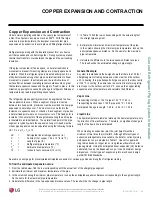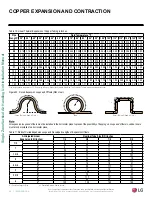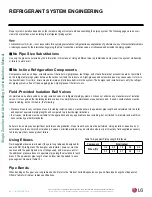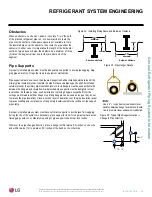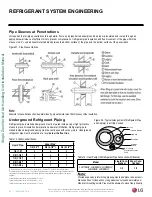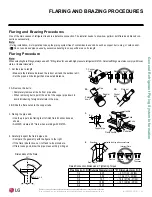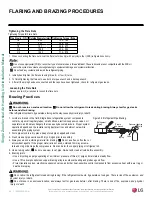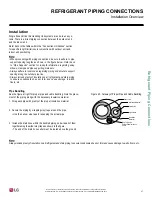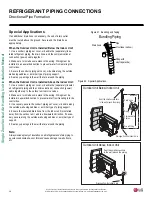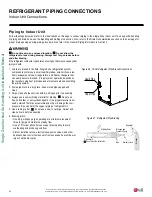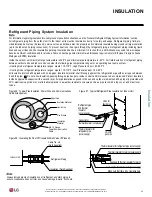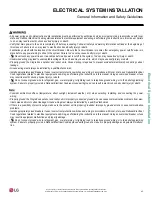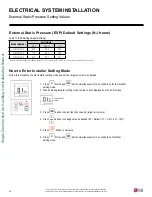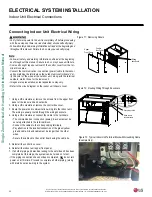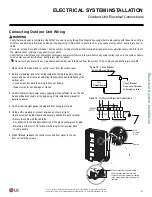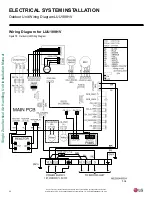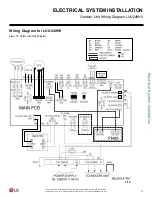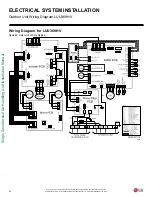
43
Insulation
Due to our policy of continuous product innovation, some specifications may change without notification.
©LG Electronics U.S.A., Inc., Englewood Cliffs, NJ. All rights reserved. “LG” is a registered trademark of LG Corp.
INSULATION
Figure 56: Typical Pipe Insulation, Power Wire and Communications
Cable Arrangement.
Figure 57: Typical Refrigerant Pipe Insulation at Indoor Unit
Refrigerant Piping System Insulation
For information regarding insulation for underground or penetration situations, see the “General Refrigerant Piping System Information” section.
All refrigerant piping from the outdoor unit to the indoor units must be insulated correctly for safety and usage. Refrigerant piping, field-pro-
vided isolation ball valves (if present), service valves, and elbows must be properly and completely insulated using closed cell pipe insulation
(up to the indoor unit piping connections). To prevent heat loss / heat gain through the refrigerant piping, all refrigerant piping including liquid
lines and vapor lines shall be insulated separately. Insulation shall be a minimum 1/2 inches thick, and thickness may need to be increased
based on ambient conditions and local codes. Table on next page lists minimum wall thickness requirements for Ethylene Propylene Diene
Methylene (EPDM) insulation.
Inside the outdoor unit, maximum pipe temperature is 248°F and minimum pipe temperature is -40°F. For field insulation of refrigerant piping
between outdoor units and indoor units, consider the following pipe temperature ranges for an operating heat pump system:
• Heating mode refrigerant temperature ranges: Liquid = 75-118°F; High Pressure Vapor = 95-220°F
• Cooling mode refrigerant temperature ranges: Liquid = 75-118°F; Low Pressure Vapor = 40-90°F
All insulation joints shall be glued with no air gaps. Insulation material shall fit snugly against the refrigeration pipe with no air space between
it and the pipe.
Do not allow insulation passing through pipe hangers, inside conduit, and/or sleeves to be compressed. Protect insulation
inside hangers and supports with a second layer. All pipe insulation exposed to the sun and outdoor elements shall be properly protected with
PVC, aluminum vapor barrier, or alternatively placed in a weather-resistant enclosure such as a pipe rack with a top cover; and meet local
codes.
Vapor Line
Liquid Line
Min. 14 Gauge
Cable
Power/Communication
Pipe Sleeve
Insulation Material
Insulation
Material
Figure 58: Insulating the Shut Off / Insulation Ball Valve (If Present).
Indoor Unit
Insulation (Field Supplied)
Cable Tie, etc.
(Field Supplied)
Refrigerant Piping
Always include plenty of insulation on all refrigerant and drain piping to
ensure condensate does not form and cause damage to walls, floors, etc.
Union for
liquid pipe
Refrigerant pipe
and thermal
insulator
(Local supply)
Union for
gas pipe
Thermal insulator for
refrigerant pipe
(Local supply)
Hose clip for
thermal insulator (Local supply)
Make sure that there is no clearance here
Overlap with thermal insulator for piping
Thermal insulator for refrigerant pipe (Local supply)
Thermal insulator for piping (Local supply)
Hose clip for thermal insulator(Local supply)
Summary of Contents for LV181HV4
Page 73: ...NOTES ...

